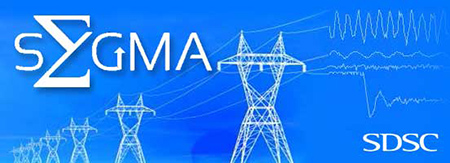UC San Diego Among Multidisciplinary Awards Providing $221M Nationally for Cutting-Edge Projects
Technology & Engineering

Engineers from academia and industry will harness the power of control theory to help improve the way electric power grids are operated in San Diego and beyond in a new research laboratory that opened this month on the University of California, San Diego campus.
Called SyGMA – for ‘Synchrophasor Grid Monitoring and Automation’ – the new industry-sponsored facility is located at the San Diego Supercomputer Center (SDSC). More information about the project can be found at http://sygma.sdsc.edu.
Sometimes called ‘the hidden technology,’ control theory can be applied to keep large systems or grid infrastructures in balance. “The principle is based on real-time monitoring: sensors take measurements of the physical environment and then the control system drives inputs to regulate and manage many different systems that interact with that environment,” said Raymond de Callafon, a professor with the Department of Mechanical and Aerospace Engineering at UC San Diego’s Jacob School of Engineering, and director of the new laboratory.
Cruise control systems in passenger cars and trucks are a good example of a control system – they are designed to calculate just how much fuel or electrical energy a vehicle needs in order to maintain a certain speed despite terrain changes. Much the same way that these cruise control systems measure velocity and control the accelerator pedal, the SyGMA lab collects and analyzes data from a device called a synchrophasor, which monitors conditions on power transmission lines. This includes currents, voltage, and specific properties of electricity such as frequency, phase angle, and real and reactive power flow.
The data will then be processed and ingested into models that will allow SyGMA researchers to develop applications to control power flow to the grid by modulating the output of ‘smart’ inverters, which are connected devices that convert direct current (i.e., the type of current that flows from batteries) into the alternating current that is used on the power grid, said de Callafon, who teaches and researches many aspects in signal processing, estimation, experiment-based modeling and adaptive control within the Dynamic Systems & Control group at the Jacobs School.
“The emerging synchrophasor network on the ‘smart’ grid is an embodiment of the much-discussed Internet of Things,” said de Callafon. “In addition to developing new systems and methods for monitoring and controlling electric grid stability, research conducted by the SyGMA Lab will impact the overall understanding of how to collect, store, and analyze data from the vast sensor networks that will eventually comprise the IoT.”
As an industry-sponsored facility, the SyGMA lab is supported by San Diego Gas & Electric (SDG&E), part of Sempra Energy; National Instruments; and OSIsoft, a manufacturer of application software for real-time data infrastructure solutions that is providing the lab with the servers for data collection of the synchrophasor measurements. In addition, the SyGMA lab will have access to the same computational tools that SDG&E uses to simulate the dynamic behavior of electric microgrids.
Keep up with all the latest from UC San Diego. Subscribe to the newsletter today.